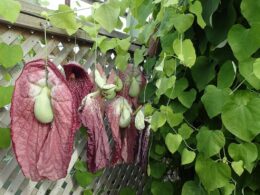In this guide, we’ll discuss everything you need to know about the Gazania flower, from their history to how to care for them. So whether you’re thinking of planting Gazanias in your garden or just want to learn more about these blooms, keep reading!
Gazania Flower – Morphology and Habitat
The Gazania flower is a bloom that belongs to the Asteraceae family. It is native to Southern Africa and gets its name from Theodore de Gaza. The flower is also known as a treasure flower or an African daisy.
Gazania petals are usually yellow, orange, or red with black markings. The flower heads are borne singly on long, leafless stems. The ray florets are typically spirally arranged, and the disc florets are tubular.
The Gazania is a hardy plant that can tolerate poor soil and little water. It is often grown as a garden plant or as a ground cover. The plant propagates easily from seed, and it can also be divided.
Gazania flowers are a good source of food for bees and other pollinating insects. The leaves of the plant are sometimes used in salads.
Gazania Plant – Soil & Sunlight
Gazania plants are native to South Africa and thrive in full sun. They are drought-tolerant and do not require much in the way of soil nutrients. Gazanias will grow in any well-drained soil, but prefer a sandy, loamy mix.
When planting, be sure to leave plenty of room for the plant to spread out. Gazanias can spread up to 1,5 feet wide. They are not particular about soil pH and will do well in both acidic and alkaline soils.
Gazanias prefer full sun, but will tolerate light shade. In very hot climates, some afternoon shade may be necessary to prevent the leaves from scorching. These plants are not frost-hardy and should be brought indoors or protected with a heavy mulch if there is any risk of frost.
Gazanias – Watering, Fertilizing, Pruning
Water Gazanias deeply but infrequently to encourage deep rooting. These plants are quite drought-tolerant once they are established. Fertilize monthly with a balanced fertilizer during the growing season. Gazanias are not heavy feeders, and too much fertilizer will result in leggy growth.
Pruning is not necessary, but may be done to remove spent blooms or to shape the plant. Gazanias bloom from spring through fall and will continue to bloom if spent flowers are removed. Deadheading is not required, but may encourage reblooming.
Growing Gazania Flowers – Propagation
Growing a Gazania flower is easy, and they make a great addition to any garden. These beautiful flowers are native to South Africa, and they thrive in sunny, dry conditions. Gazania flowers come in a variety of colors including yellow, orange, pink, red, and white.
There are two ways to propagate Gazania plants – by seed or by division. Seeds can be sown indoors in late winter or early spring. Sow the seeds on the surface of a well-drained seed-starting mix and keep them moist but not wet. The seeds will germinate in 14-21 days.
Once the plants have several sets of true leaves, they can be transplanted outdoors. If you live in a climate with warm summers, you can direct sow the seeds outdoors in late spring or early summer.
To propagate Gazania by division, wait until the plants are dormant in late fall or early winter. Dig up the entire plant and carefully divide it into several sections, making sure each section has several roots and at least one bud. Replant the divisions immediately and water them well.
Gazania Flower – Pests and Diseases
Gazania flowers are beautiful, vibrant blooms that add color and life to any garden. However, like all plants, they are susceptible to pests and diseases. Some of the most common problems that can affect the Gazania flower include aphids, powdery mildew, and rust.
To prevent or treat these issues, it is important to properly care for your plants. Make sure to water them regularly, remove any infected parts of foliage, and fertilize them according to the manufacturer’s instructions. Additionally, you can use a pesticide or fungicide to prevent or treat pests and diseases. Be sure to follow the directions on the label carefully.
Are Treasure Flowers Annual or Perennial?
The answer to this question depends on the species of Gazania. Some are annuals, meaning they only bloom for one season and then die. Others are perennials, meaning they come back year after year. Still others are evergreen, meaning they remain green and blooming all year round. So, if you’re not sure which type of Gazania flower you have, it’s best to ask an expert. We recommend a Gazania rigens – a stunning species, which is very popular among gardeners.



















